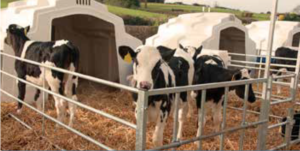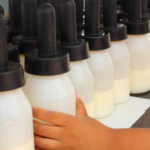Hygiene Protocols For Successful Calf Raising
Click here to view as a pdf: Hygiene Protocols For Successful Calf Raising
By Erik Brettingen, B.S.
Every calf raiser knows that keeping calves healthy is neither simple nor easy. When a calf’s exposure to pathogens “outweighs” its immune resources, the results are clinical illness. One of the keys to keeping calves healthy is reducing disease causing pathogens at their source using proper hygiene procedures.
The three primary pathogen exposure points for newborn and pre-weaned calves are maternity pens, calf housing, and calf feeding equipment/utensils. By systematically identifying the primary pathogens at each of these exposure points, a producer can select the most efficacious hygiene protocol to reduce harmful pathogens in the calf’s environment.
Although monitoring and documenting the effectiveness of a sanitation protocol is important, the identification and isolation of sick animals may also need to be implemented to prevent the further spread of disease.
To help you carry out these hygiene practices effectively, Crystal Creek® now carries Acepsis Exact Tablets and Acepsis Calf Hygiene Activator and Base; which are chlorine dioxide based sanitizers. Chlorine dioxide is a versatile sanitizing agent that has been proven to be extremely effective against the most durable pathogens. These sanitizers, when added to water, make a concentrated solution of chlorine dioxide. Specific mixing instructions for creating a 500 ppm concentrate solution are found on the product label.
In an effort to better manage the calf development process, the following hygiene practices have been identified.
Maternity Pen Hygiene Procedures:
Provide Fresh/Clean Bedding: For optimal newborn health, calves must be delivered in a clean, dry area, maintaining minimal pathogen exposure. To meet this goal, Crystal Creek® recommends bedding with 25 pounds of long stem straw per 1,000 pounds of animal body weight per day. In general, coliform bacteria (from fecal matter) are the most dangerous pathogens present in every calving area. Maternity pens should be cleaned and disinfected after each calving.
Navel Dipping: Careful and consistent navel dipping is a hygiene step that not only kills pathogens at the navel opening but also helps close the umbilical cord.
Separation of Calf from Dam: Separating the calf from the dam shortly after birth is an important hygiene procedure. By controlling this aspect of the calf’s environment, you are removing a huge source of fecal bacteria from the calf’s environment.
CLEANING THE MATERNITY PEN (Concrete Flooring)
- Remove bedding from the calving area between each calving. If the calving pen floor is concrete, rinse floor area removing as much organic material as possible.
- Apply a chlorinated alkaline foaming detergent (see Chlor-A-Foam in the Crystal Creek® catalog) with hot water (140°F/60°C) to all pen surfaces using a hand held foamer. Soak for approximately 10–15 minutes.
- Rinse with water. Allow pens to dry.
- Use Acepsis Calf Hygiene Concentrate as the final step in the calving pen cleaning process. The solution should be used at a concentration of 100 ppm and sprayed on all pen surfaces for maximum protection
- Allow to dry prior to re-bedding the pen.
- Re-bed calving area with clean/fresh bedding.
Pre-Weaned Calf Housing Hygiene Procedures:
Keep calves away from wet conditions that support pathogen survival and growth. Providing ample drainage and a dry environment is an effective weapon against bacteria and parasites.
CLEANING CALF HUTCHES / PENS (With Sand / Clay Flooring)
- Remove the bedding and top layer of sand/clay between calves.
- Spray top layer of sand/clay with 100 PPM of Acepsis Calf Hygiene Concentrate.
- Let dry for approximately 1 hour prior to re-bedding calf hutch.
- Clean calf hutches/pens as per previous washing instructions.
- Rinse with water. Allow pens to dry.
- Use Acepsis Calf Hygiene Concentrate as the final step in the calving pen cleaning process. A solution of 100 PPM of ClO2, should be sprayed on all pen surfaces for maxiumum hygiene protection. Allow to dry prior to re-bedding the pen.
Calf Feeding Equipment / Utensils Hygiene Procedures:
Because feeding equipment comes in direct contact with the calf’s mouth, disinfection is crucial in preventing the spread of disease. Careful attention to cleaning protocols will decrease the pathogenic load on bottles, nipples, buckets and other feeding equipment resulting in healthier calves.
CLEANING CALF FEEDING EQUIPMENT AND UTENSILS
- Rinse all equipment/utensils with warm water (110°F/45°C) removing organic material before washing.
- Soak the equipment/utensils in hot water (140°F/60°C) with a chlorinated alkaline detergent (pH of 10–11) for approximately 5 minutes.
- Wash vigorously with a brush for 1–2 minutes.
- Remove alkaline solution and fill sink with cold rinse water.
- Add Calf Hygiene Concentrate to the rinse water creating a 50 PPM ClO2solution.
- Let sit and allow to air dry prior to use.
Implementing these sanitation protocols will reduce the load of pathogens calves are exposed to every day. An effective sanitation protocol gives the immune system the advantage it needs to keep calves healthy, saving you time and money by reducing treatments. It is important to note that while these products and procedures are very efficacious, they only work if protocols are carried out correctly, consistently and measured for effectiveness. To learn more about the importance of implementing effective sanitation protocols, see ”Understanding Bio-Films in Agriculture” by Jessica Dercks.




